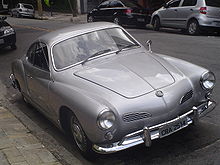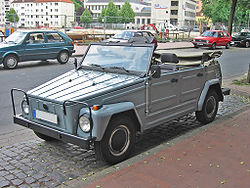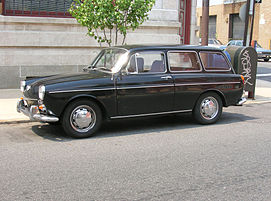Volkswagen Karmann Ghia
 | |
| Manufacturer | Volkswagen |
|---|---|
| Production | Germany 1955–1974 445,238 built Coupé: 364,401 Cabriolet: 80,837 Brazil 1962-1975 41,689 built Coupé: 23,393 Cabriolet: 177 TC: 18,119 |
| Assembly | Osnabrück, Germany São Bernardo do Campo, Brazil |
| Successor | Volkswagen Scirocco |
| Class | coupé |
| Body style | 2-door convertible 2-door coupe |
| Layout | RR layout |
| Engine | 1200cc,1500cc or 1600cc F4 |
| Related | Volkswagen Beetle |
| Designer | Luigi Segre |
The Volkswagen Karmann Ghia is a 2+2 coupe and convertible marketed from 1955 to 1974 by Volkswagen – combining the chassis and mechanicals of the Type 1 (Beetle), styling by Luigi Segre of the Italian carrozzeria Ghia, and hand-built bodywork by German coach-builder Karmann.
The Karmann Ghia was internally designated the Type 14. Volkswagen later introduced a variant in 1961, the Type 34 – featuring angular bodywork and based on the newly introduced Type 3 platform.
Production doubled soon after its introduction,becoming the car most-imported into the U.S. American industrial designer Walter Dorwin Teague selected the Type 14 for his list of the world's most beautifully designed products.
Over 445,000 Karmann Ghias were produced in Germany over the car's production life – not including the Type 34 variant. Karmann Brazil produced 41,600 cars locally for South America between 1962 and 1975.
History
The Type 14 debuted at the October 1953 Paris Auto Show as a styling concept created for Ghia by Luigi Segre.
In the early 1950s, Volkswagen was producing its economy car, the Type 1 (Beetle). With an increase in post-war standards of living, executives at Volkswagen proposed adding a halo car to its model range, contracting with German coachbuilder Karmann for its manufacture. Karmann in turn contracted the Italian firm Ghia, who adapted styling themes previously explored for Chrysler and Studebaker to a Beetle floorpan widened by 12 in (300 mm).
In contrast to the Beetle's machine welded-body with bolt-on fenders, the Karmann Ghia's body panels were butt-welded, hand-shaped and smoothed with English pewter in a time-consuming process commensurate with higher-end manufacturers – and resulting in the Karmann Ghia's higher price.
The design and prototype were well-received by Volkswagen executives, and in August 1955 the first Type 14 was manufactured in Osnabrück, Germany. Public reaction to the Type 14 exceeded expectations, with over 10,000 sold in the first year.
The Type 14 was marketed as a practical and stylish 2+2 rather than as a true sports car. As they shared engines, the Type 14's engine displacement grew concurrently with the Type 1 (Beetle), ultimately arriving at a displacement of 1584 cc, producing 60 hp (45 kW).
In August 1957, Volkswagen introduced a convertible version of the Karmann Ghia. Exterior changes in 1961 included wider and finned front grilles, taller and more rounded rear taillights and headlights relocated to a higher position – with previous models and their lower headlight placement called lowlights. The Italian designer Sergio Sartorelli,designer of Type 34, oversaw the various restylings of Type 14.
The 1967 Type 14 Karmann Ghia convertible gained notoriety on American television as being the car driven by CONTROL Agent 86 Maxwell Smart in the opening credits of the third and fourth seasons of Get Smart. Like the Sunbeam Tiger before it, (which remained the car driven by Smart in the episodes themseleves), the character would be seen in the opening credits screeching to a halt outside of his headquarters. The Karmann Ghia was replaced in the final season credits of the show however, by the Opel GT. In the 2008 film of the same name, a Karmann Ghia once again made an appearance driven by Smart, along with its two sister cars, though the car in the film was a model from 1970. The Karmann Ghia is also the subject of a secret pass phrase in the 2011 movie Cars 2.
In 1970, larger taillights integrated the reversing lights and larger wrap-around turn signals. Still larger and wider taillights increased side visibility and at the same time large square-section bumpers replaced the smooth round originals. For the USA model only, 1973 modifications mandated by the National Highway Traffic Safety Administration (NHTSA) included energy-absorbing bumpers. A carpeted package shelf replaced the rear seat.
In late 1974 the car was superseded by the Golf ("Rabbit" in USA)-based Volkswagen Scirocco.
| Karmann Ghia (1963) | |||||||||
|---|---|---|---|---|---|---|---|---|---|
| Engine | Displacement | Power | Torque | Wheelbase | L × W × H (mm) | Weight | Top speed | 0→100 km/h | Fuel cap. |
| OHV four-stroke air-cooled flat 4 "Volkswagen", 1 single Solex 28 PICT carburettor | 1,192 cc (77 x 64 mm) | 34 PS (25 kW) at 3,600 rpm | 8.4 kg·m (82.4 N·m) at 2,000 rpm | 2,40 m | 4,14×1,63×1,33 | 820 kg | 120 km/h (75 mph) | ||
| OHV four-stroke air-cooled flat 4 "Volkswagen", Modified with double Solex 32 PBIC carburettor and OKRASA long-stroke crankshaft. | 1,295 cc (77 x 69.5 mm) | 50 PS (37 kW) at 4,200 rpm | 9.6 kg·m (94.1 N·m) at 2,800 rpm | 150 km/h (93 mph) | |||||
| Karmann-Ghia taillight comparison | |||||||||
Type 34 Karmann Ghia
In September 1961, Volkswagen introduced the VW 1500 Karmann Ghia, or Type 34,' based on its new Type 3 platform, featuring Volkswagen's new flat 1500cc engine design, and styling by Italian engineer Sergio Sartorelli. Due to model confusion with the Type 14 1500 introduced in 1967, the Type 34 was known variously as the "Der Große Karmann" ("the big Karmann") in Germany, "Razor Edge Ghia" in the United Kingdom, or "European Ghia" (or "Type 3 Ghia" among enthusiasts) in the United States. Today the name Type 34 is recognized as the worldwide naming convention.
The second automobile model in the world to have this option, an electrically operated sliding steel sunroof was optional in 1962. The styling offered more interior and cargo room than the original Karmann Ghia. It featured an electric clock, three luggage spaces, built-in fog lights, round tail lights, upper & lower dash pads, door pads, & long padded armrests. It was the fastest production VW model of its day.
Until it was replaced by the VW-Porsche 914, it was the most expensive and luxurious passenger car VW manufactured in the 1960s — back then you could have purchased two basic Beetles for the price of one Type 34 in many markets. The comparatively high price meant it never generated high demand, and only 42,505 (plus 17 prototype convertibles ) were built over the car's entire production life between 1962 and 1969 (roughly 5,000 a year). Today, the Type 34 is considered a semi-rare collectible with values ranging from US$25K (nice original or restored) to $8K (driving project) to $3K (non-driving parts car). Values in Europe are the highest with an unrestored original Pearl White 1962 Coupe selling for US$34,000 in Germany in late 2010.
Although the Type 34 was available in most countries, it was not offered officially in the U.S. — VW's largest and most important export market — another reason for its low sales numbers. Many still made their way to the USA (most via Canada), and the USA has the largest number of known Type 34s left in the world (400 of the total 1,500 to 2,000 or so remaining).
Like its Type 14 brother, the Type 34 was styled by the Italian design studio Ghia. There are some similar styling influences, but the Type 14 Ghia looks very different from the Type 34. The chassis is also a major difference between the cars: the Type 14 shares its chassis with a Beetle, whereas the Type 34 body is mounted on the Type 3 chassis and drive train (the same as in a 1500/1600 Notchback, Variant (Squareback) and Fastback) — all distinguished by the standard 1500 pancake engine that allowed a front and rear boot. The Type 34 is mechanically the same as other Type 3s. All bodywork, interior, glass, bumpers, and most of the lenses are unique to the Type 34.
The Wilhelm Karmann factory assembly line which assembled the Type 34 also produced the VW-Porsche 914 (known as Porsche 914 in the USA) — the Type 34's replacement.
Karmann Ghia TC
As an alternative to the Type 34 Karmann-Ghia coupé, which Volkswagen had introduced to Europe in 1961, Karmann-Ghia do Brasil looked to Ghia in Turin for a reworked version of the Type 14 at the end of the 1960s. At the time Ghia employed Giorgetto Giugiaro, the famous Italian designer and he was set to work on the new Brazilian Karmann Ghia. The result was the Volkswagen Karmann Ghia TC (Touring Coupé), internally known as the Type 145, which was introduced in 1970.
This model looked much like an Italian impression of a Porsche 911 and was a roomy 2+2 coupe with a modern and comfortable interior. Underneath it was similar to the Type 14 though actually the platform of the Volkswagen Variant was used rather than that of the Volkswagen Beetle. The main difference was the engine: the Type 145 TC was fitted with the 1584 cc flat-four air-cooled boxer unit from the Type 3 instead of the 1192 cc unit of the Type 14. The car had 65 hp (48 kW) @ 4600 rpm and a top speed of 86 mph (138 km/h), compared to the 34 hp (25 kW) and 72 mph (116 km/h) of the Type 14.
18,119 TC models were produced during its production run from 1970 until 1976. It was only offered in South America and wasn't exported off the continent. There is a prototype that is part of the factory museum collection of Karmann in Osnabrück, Germany.




















![Validate my RSS feed [Valid RSS]](valid-rss-rogers.png)














































































